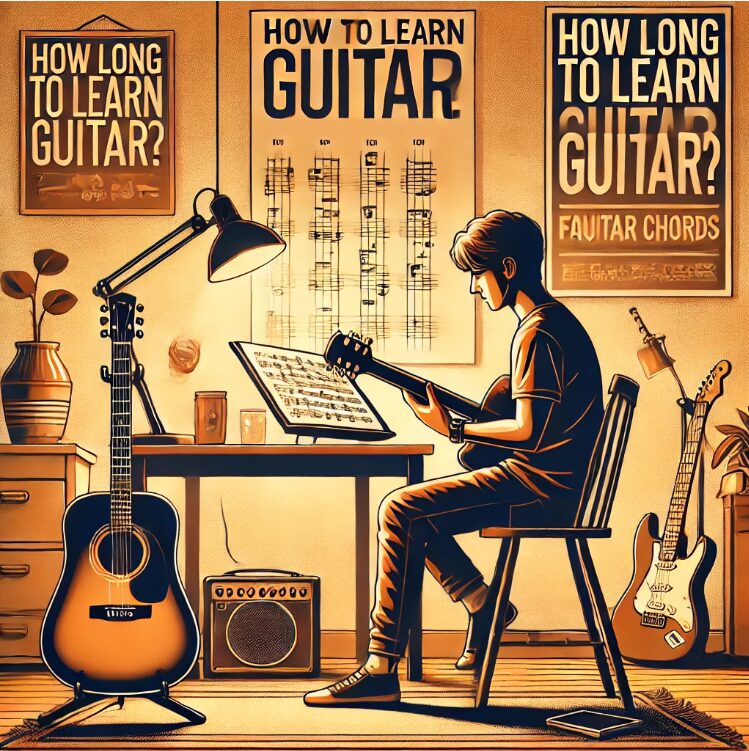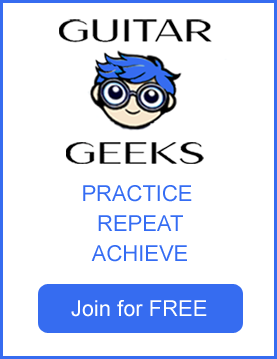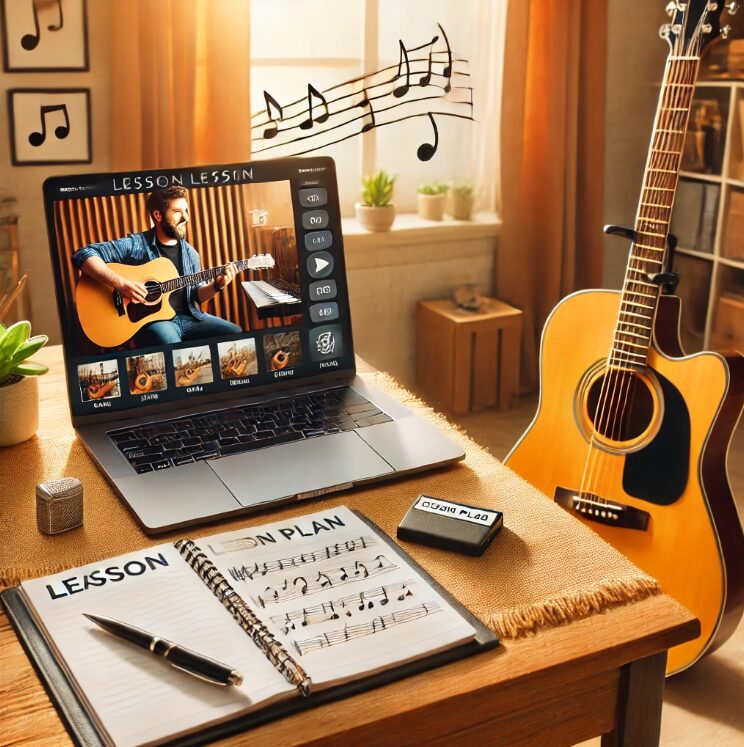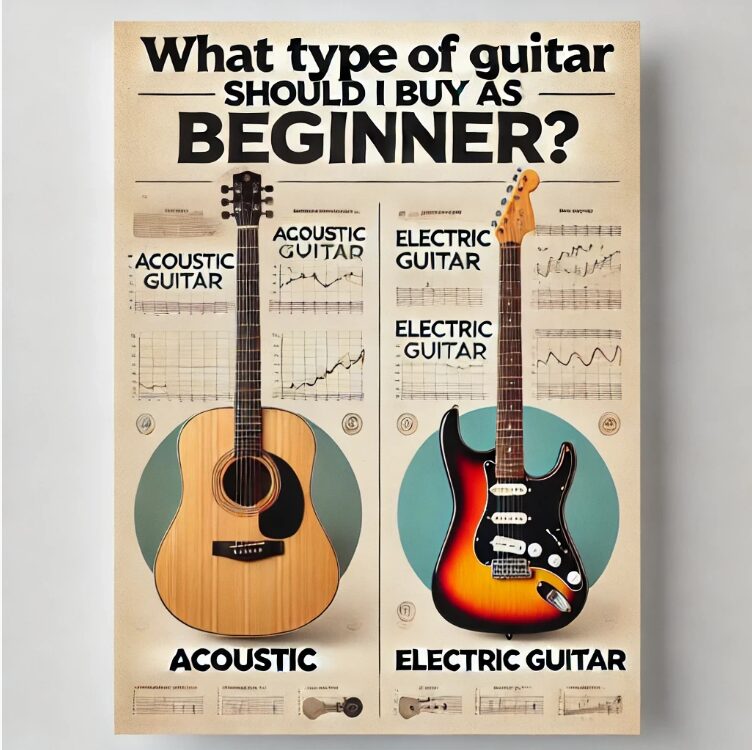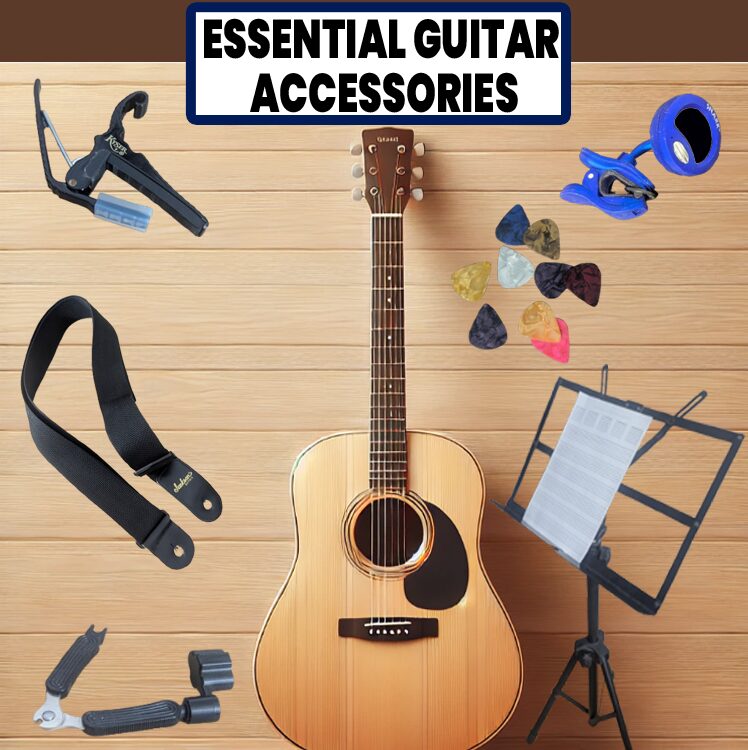Please login to bookmark
If you’re considering learning guitar, one of the first questions you might have is: “How long will it take me to learn?” The answer depends on several factors, including your goals, practice habits, and the time you dedicate to learning. Let’s break it down to give you a clearer picture.
1. Define “Learning Guitar”
The definition of “learning guitar” varies from person to person. Are you looking to:
- Strum a few chords and play basic songs? This might take just a few weeks.
- Play intermediate-level songs, including barre chords and riffs? Expect several months to a year.
- Master advanced techniques, such as solos or fingerpicking? This journey often takes years.
Understanding your goals will help you set realistic expectations and track your progress.
2. Factors That Influence Learning Time
Several key factors affect how quickly you can learn guitar:
a) Practice Time
- Practicing 10–15 minutes a day consistently can lead to noticeable progress within a few weeks. Short practice sessions are better for beginners as they help prevent fatigue and allow you to stay focused. Take breaks if your fingers get sore and then go for another quick session once you’ve had a rest.
- Gradually increasing your daily practice time by 5 to 10 minutes as you build finger strength and stamina can significantly boost your learning process.
b) Quality of Practice
- Focused, structured practice yields faster results than aimless strumming. Use resources like practice plans, chord charts, and tutorials to stay on track. While practicing stay away from other sources like YouTube to avoid getting distracted by jumping around lesson to lesson. Many so-called beginner lessons on YouTube are not truly designed for beginners and may leave you frustrated. Stick to resources that match your skill level to ensure steady progress.
c) Learning Method
- Working with a teacher or structured course often leads to faster progress than self-teaching. You probably don’t need weekly lessons, but a check-up on your technique once in a while can help you correct issues or inefficiencies in your playing.
- Online tools and memberships, like those offered by Guitar Geek Academy, can provide the structure you need to progress efficiently. Short micro-lessons (check-up lessons) can also help you stay on track by focusing on specific skills or techniques without overwhelming your practice routine.
d) Your Background
- Prior experience with other instruments or basic music theory can shorten the learning curve. For instance, if you’ve played piano or another string instrument, you might already understand chord structures or rhythm patterns, giving you an advantage when picking up the guitar.
- Your physical comfort with the guitar (e.g., finger strength and dexterity) also plays a role. Beginners often need time to develop calluses on their fingertips and adjust to the physical demands of pressing down strings accurately. This process can be accelerated by consistent practice and proper technique.
- Additionally, your familiarity with music notation or tablature can make learning songs and techniques much faster, reducing frustration in the early stages of your journey.
3. The Role of Practice Repetition
Repetition is one of the most powerful tools for mastering the guitar—but only when done properly. By repeating specific exercises or patterns correctly, you train your fingers and mind to perform them effortlessly over time. However, practicing something incorrectly can engrain bad habits, making progress slower or even setting you back. Here are some key aspects of effective practice repetition:
a) Muscle Memory
- Consistently repeating chords, scales, or riffs helps build muscle memory. This means your fingers will instinctively know where to go, reducing hesitation and improving speed.
b) Breaking Down Complex Skills
- Break challenging songs or techniques into smaller parts and repeat them individually. For example, practice the progression G – Em – C – D by isolating each chord transition. Practice G to Em back and forth, then Em to C, C to D, and finally D to G. By focusing on these smaller transitions, you’ll get more practice and achieve quicker results before attempting the full progression.
c) The Power of Slow Practice
- Start slow and focus on accuracy. Repeating an exercise slowly and correctly prevents bad habits and ensures clean execution when you eventually speed up.
d) Spaced Repetition
- Instead of cramming, spread your practice across multiple sessions. Returning to a skill or exercise after a break reinforces learning and helps it stick long-term.
e) Tracking Progress
- Use practice logs to monitor how often you repeat specific exercises. This not only keeps you accountable but also highlights areas where repetition has led to improvement.
Repetition doesn’t mean mindless playing. When you practice correctly, each repetition becomes a small victory, leading to noticeable progress over time. Focused, intentional practice is key to success.
4. Stages of Guitar Learning
Here’s a general timeline for different stages of learning:
- First Month: Learn basic chords (G, C, D, Em, Am) and simple strumming patterns. Play your first song.
- 1–3 Months: Improve chord transitions, explore more strumming patterns, and play basic songs confidently.
- 3–6 Months: Add barre chords, basic fingerpicking, and simple riffs. Experiment with playing in time with backing tracks.
- 6–12 Months: Develop more complex rhythm techniques, master common progressions, and start improvising or playing lead guitar.
- 1 Year and Beyond: Dive into advanced techniques like soloing, advanced fingerpicking, and learning music by ear. This is also when you’ll feel your personal style beginning to emerge.
Tip: During the first couple of months, if you want to keep things simple, purchase a guitar capo. A capo allows you to play a wider variety of songs with basic chords, making it easier to sound great while building your skills and gaining confidence while working on new skills, chords, and strumming patterns.
5. Tips to Learn Faster
- Set Clear Goals: Whether it’s playing a specific song or mastering a technique, goals keep you motivated.
- Practice Regularly: Daily practice, even in small increments, is more effective than occasional long sessions.
- Use Resources: Explore online lessons, books, and tools tailored to your skill level. Check out Guitar Geek Academy’s beginner resources to get started.
- Track Your Progress: Use practice logs or apps to monitor your improvement. Make note of your progress on specific skills like chord transitions, strumming patterns, or playing in time with a metronome.
- Focus on Problem Areas: Identify areas where you struggle and dedicate extra time to them. For example, if barre chords are challenging, add focused exercises to your routine to strengthen finger positioning and dexterity.
- Play Along with Music: Practicing along with backing tracks or songs can improve timing, rhythm, and ear training. This also makes practice sessions more engaging. Slow the music down so you can play along more easily and build confidence. As you improve, gradually speed it up to match the original tempo, helping you develop precision and adaptability.
- Stay Patient and Positive: Everyone learns at their own pace. Celebrate small victories along the way, and remember that consistency is more important than perfection in the early stages.
6. Common Challenges and How to Overcome Them
Learning guitar can be challenging at first. Here are some common hurdles and strategies to overcome them:
- Finger Pain: Building calluses takes time. Practice shorter sessions more frequently and consider using lighter-gauge strings.
- Chord Switching: Slow down and focus on clean transitions. Practice switching between two chords repeatedly to build muscle memory.
- Frustration with Progress: Progress can feel slow. Celebrate small milestones, like mastering a new chord or song.
7. The Role of Motivation and Fun
Staying motivated is crucial to long-term success. Play songs you enjoy and experiment with different genres. Guitar is as much about personal expression as it is about skill-building.
8. Equipment Tips for Beginners
- Guitar Picks: Try different thicknesses to see what feels comfortable. Start with a medium gauge pick to get a balanced feel, and then experiment with thinner or thicker picks to find what works best for your playing style and preferences.
- Tuner: Always tune your guitar before practice. A clip-on tuner ensures you’re always in tune, which makes practicing more enjoyable. It sounds better, your ears will appreciate it, and you’ll likely find yourself practicing longer.
- Capo: As mentioned earlier, a capo opens up more song options with basic chords.
9. Ready to Get Started?
Looking for structured workouts and support? Check out Guitar Geek Academy for beginner-friendly resources and expert guidance.
Subscribe to our newsletter for practice tips and exclusive resources to help you on your guitar journey!
10. Enjoy the Journey
Learning guitar is a lifelong journey, and there’s always something new to discover. While the time it takes to learn depends on your goals and dedication, the rewards of playing are worth every minute. Start small, stay consistent, and enjoy making music!


